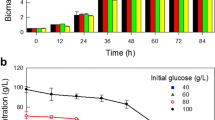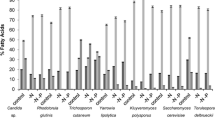Abstract
Because of the diversity of their lipids and fatty acid biosynthetic pathways, lower fungi may find utilization as sources of omega-3 or other polyunsaturated fatty acids (PUFA). Production of eicosapentaenoic acid (EPA) by the filamentous fungus, Pythium irregulare, has been demonstrated in 14-1 fermentors. Sweet whey permeate (lactose) was preferred over glucose as a substrate for production of a high-EPA-content lipid. Characterization of the lipid indicated that approximately 90% of the EPA was contained in the neutral lipid fraction. A specific productivity of 24.9 mg EPA/g dry biomass was achieved at 14°C, at which temperature the lipid contained 25.5% EPA and 54.2% PUFA. This is the highest mycelial EPA content for a fungal lipid that has been reported in the literature.
Similar content being viewed by others
References
Bajpai PK, Bajpai P, Ward OP (1992) Optimisation of cultural conditions for production of eicosapentaenoic acid by Mortierella elongata NRRL 5513. J Ind Microb 9:11–18
Bhatia IS, Raheja RK, Chahal DS (1972) Fungal lipids: I. Effect of different nitrogen sources on the chemical composition. J Sci Food Agric 23:1197–1205
Folch J, Lees M, Sloan-Stanley GH (1957) A simple method for the isolation and purification of total lipids from animal tissue. J Biol Chem 226:497–509
Gandhi SR, Weete JD (1991) Production of the polyunsaturated fatty acids arachidonic acid and eicosapentaenoic acid by the fungus Pythium ultimum. J Gen Microbiol 137:1825–1830
Kendrick A, Ratledge C (1992) Lipid formation in the oleaginous mould Entomophthora exitalis grown in continuous culture: effects of growth rate, temperature and dissolved oxygen tension on polyunsaturated fatty acids. Appl Microbiol Biotechnol 37:18–22
Neidleman SL (1987) Effects of temperature on lipid unsaturation. Biotechnol Genet Eng Rev 5:245–268
Radwan SS (1991) Sources of C20-polyunsaturated fatty acids for biotechnological use. Appl Microbiol Biotechnol 35:421–430
Seto A, Wang HL, Hesseltine CW (1984) Culture conditions affect eicosapentaenoic acid content of Chlorella minutissima. J Am Oil Chem Soc 61:892–894
Shimizu S, Kawashima H, Shinmen Y, Akimoto K, Yamada H (1988) Production of eicosapentaenoic acid by Mortierella fungi. J Am Oil Chem Soc 65:1455–1459
Simopoulos AP (1989) Summary of NATO advanced research workshop on dietary ω3 and ω6 fatty acids: biological effects and nutritional essentiality. J Nutr 119:521–528
Slover HT, Lanza E (1979) Quantitative analysis of food fatty acids by capillary gas chromatography. J Am Oil Chem Soc 55:933–937
Wessinger EW, O'Brien DJ, Kurantz MJ (1990) Identification of fungi for sweet whey permeate utilization and eicosapentaenoic acid production. J Ind Microb 6:191–197
Author information
Authors and Affiliations
Additional information
Correspondence to: D. J. O'Brien
Rights and permissions
About this article
Cite this article
O'Brien, D.J., Kurantz, M.J. & Kwoczak, R. Production of eicosapentaenoic acid by the filamentous fungus Pythium irregulare . Appl Microbiol Biotechnol 40, 211–214 (1993). https://doi.org/10.1007/BF00170368
Received:
Accepted:
Issue Date:
DOI: https://doi.org/10.1007/BF00170368




